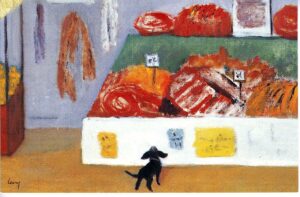Bedlam with Corned Beef on the Side Part II
Written by Barry Kessler. Originally published in Generations 1993, reprinted in Generations 2011 – 2012: Jewish Foodways.
Part II: The Old Neighborhood

Color slide of ”Lexington Market” by Ruth Bear Levy. JMM 1999.012.013
In Baltimore, Jewish immigrants settled in the small brick rowhouses of East Baltimore, a neighborhood bounded more or less by the Jones Falls and Patterson Park on the west and east, Orleans Street on the north and Eastern Avenue on the south. There were also immigrant neighborhoods in West Baltimore and South Baltimore; other Jewish families were scattered throughout the city, often living about their small grocery, liquor, jewelry, and clothing stores. By the 1920s, Eastern European Jews were migrating to the northwestern part of Baltimore in significant numbers and within forty years few stiff resided downtown, although they may have worked or shopped there.
The nucleus of the old East Baltimore neighborhood was along Baltimore and Lombard Streets, west of Central Avenue, where synagogues, shops, community institutions, and the densest Jewish population were concentrated. Lombard Street was a bustling marketplace. Along its length stores catering to both Jewish and Gentile trade sold clothing, shoes, and sundries, as well as foodstuffs in teeming variety. Besides a mingling of Italian groceries toward the Jones Falls, virtually every store was owned by an immigrant Jewish family. Baltimore Street had a more residential character, but many of the homes had ground-level shop fronts, especially on the corners.
Groceries, bakeries, butchers, confectioners, and dairies sprang up in the neighborhood to supply the immigrant community, preparing, importing, and selling traditional foods, just as in other ethnic communities. Some of the groceries may have called themselves delicatessens, but it was not until 1905 that there was a sufficient number to require a separate business category in the Baltimore City Directory under that heading.[1]
Five delicatessens were listed in that year, three of them on East Baltimore Street between Front and Exeter Streets. Harry Caplan’s delicatessen was at 915 East Baltimore Street, Frank Hurwitz’s two doors away at number 919, and Harry Goodman’s in the next block at 825 East Baltimore Street. Solomon Goldberg was around the corner at 537 Asquith Street. Isaac Baer’s shop at 1802 Division Street was the only delicatessen listed outside of East Baltimore. In preceding years Solomon Goldberg had been listed as a butcher, Harry Goodman as a grocery and under “meats,” and Frank Hurwitz as a butcher and a grocer.
Continue to Part III: Caplan’s Delicatessen
Notes:
[1] Baltimore City Directory, R.L. Polk and Company, 1905.
